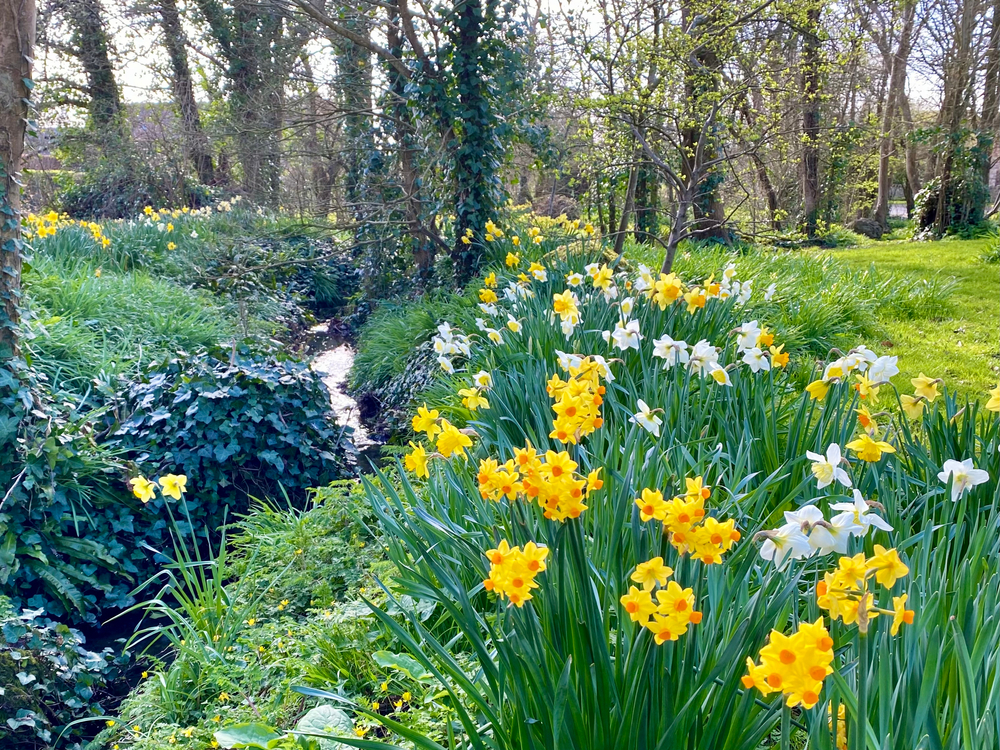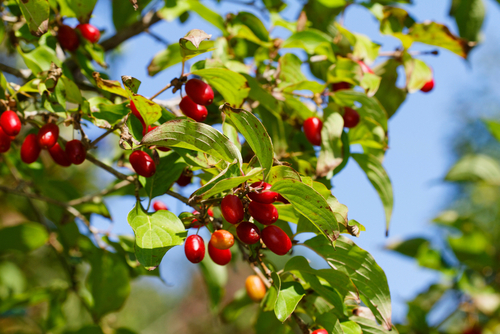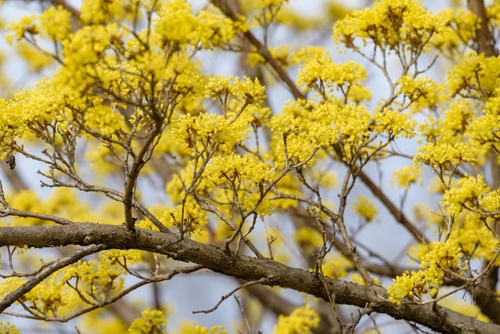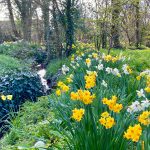
Countryside Corner
Neighborly Garden News
Issue 120
April 2022
Dear readers; please visit our website: www.countrysidelandscape.net for the safety measures we have in place during this pandemic.
Help save the butterflies: create a Monarch habitat!
Watching butterflies visit your garden is one of the joys and wonder of being a gardener, or visiting a garden. Even schoolchildren know that most butterflies sustain themselves solely on a diet of nectar from flowers; hence the importance of providing pesticide-free flowers for them. A few species of butterflies feed on tree sap, or rotting organic matter; Magic Wings Butterfly conservatory, in South Deerfield, sets out platters of over-ripe fruit for some of their butterflies to feed on.
The most important need for Monarchs, besides a clean and reliable food source, is breeding habitat. Unlike some other species of butterflies which will lay eggs and develop on a few types of ‘host’ plants. Monarchs are obligated to only lay eggs on plants in the Milkweed (Asclepias) family. As the young Monarch caterpillars eat the leaves of Milkweed plants, they ingest its toxic sap, which renders the caterpillar toxic as well. The bright colors of the caterpillar and the adult butterfly serve as warnings to potential predators that these insects are poisonous. One other species of butterfly takes advantage of the protective coloration that the Monarch uses; the Viceroy Butterfly, Limenitis archippus, mimics the Monarch Butterfly’s coloration so well, you need to be an expert to tell them apart, and neither can the predators.

Asclepias tuberosa
Of the 100 species of Milkweed native to North America, only about 25% are beneficial to Monarch butterflies. They prefer the species with the higher amounts of toxicity in the plant sap. There are eight Milkweed species native to Massachusetts: Asclepias tuberosa, Butterfly Weed, A. syriaca, Common Milkweed, A. amplexicaulis, Clasping Milkweed, A. quadrifolia, Fourleaf Milkweed, A. exaltata, Poke Milkweed, A. purpurascens, Purple Milkweed, A. incarnata, Swamp Milkweed, A. verticillata, Whorled Milkweed. Four of these are very easy to find for sale; Common, Purple, Swamp and Butterfly Weed, and make very attractive garden plants, in addition their value for Monarchs.

Common Milkweed
Some localities classify Milkweed as a noxious weed, because of its potential to poison cattle and other livestock; please be cautious if this may pertain to you. By reserving a portion of your garden space to be left as an undisturbed Milkweed patch, you’d be fostering generations of caterpillars that could help the migration of Monarchs continue through our children’s and grandchildren’s lifetime.

Swamp Milkweed
If you’ve ever seen a lone outcropping of Milkweed, growing along some dusty road, you’d realize how tough and adaptable it is. Even the swamp Milkweed, will grow either in or out of swampy areas, but prefers consistent moisture. Most Milkweeds will form dense clumps over time, so you may anticipate being able to pass along your extra plants or increase your Monarch garden by regularly dividing the clumps. Milkweeds are prone to getting aphids, despite the toxicity of their sap. These are easily washed off with a hose sprayer; remember not to use any kind of pesticide that could harm the butterflies or caterpillars. Butterfly Weed (Asclepias tuberosa) prefers very well drained sandy soil, and all Milkweed species do best in poor, low fertility soils; so no extra fertilizer is necessary.
Once you learn to I.D. Monarch caterpillars, you will be able to track the lifecycle of your resident butterflies, and maybe you might get to see one hatch and fly away! Don’t mow your Milkweed patch until you no longer see any caterpillars on the plants, or at the very end of the growing season.
April’s to-do list
It’s been a joy to see the buds of trees swelling and spring bulbs coming up. Last winter seemed mild compared to previous years. Still, winter is a cold and barren period for gardeners. Driving back from NYC last week, I saw many Redbud trees (Cercis canadensis) in bloom along the Hutchinson River Parkway, a sight for sore eyes! Spring is on the way, and we will begin our cycle of bloom in Western MA, too. I’ve had a pretty show of blooms from the earliest blooming plants in my garden; snowdrops (Galanthus nivalis) and hybrid Witch hazel (Hamamelis x intermedia ‘’Diana’) beginning in late February.
Ticks will become active at temperatures above 39’F. They are most active between April and October; peaking June through August. Take precautions when working or playing outdoors; long-sleeves, long pants, and use an insect repellent. Modify your landscape to minimize areas where the tick’s hosts will live, and where ticks can propagate. We offer several types of tick control products, designed to kill ticks and control their hosts. Please contact Scott Higley, (scott@countrysidelandscape.net) at our office for more information.
Begin digging and dividing any perennials you didn’t get to last fall. Doing this early, and in cool weather, lessens transplant shock; with minimal effect on their blooming. Please be sure your flower bed is dry enough to work in; squeeze a ball of soil tightly in your hand, and then release. Poke the soil ball with your finger, if the ball ‘shatters’ it is dry enough to work. If the ball stays together, wait a bit longer for the soil to dry.
Prune Roses this month, for the best June blooms. Begin pruning rosebushes as the buds begin to swell. This helps to identify living from dead wood. Prune small twigs less than the diameter of a pencil, and any broken, diseased, or inward growing branches. Make your cut above an outward facing bud or node to keep the center of the plant open and airy. Prune Climbing roses and heirloom (non-re-blooming) roses after they bloom, so as not to interrupt their bloom cycle. Roses are actually rejuvenated after a hard spring pruning.
Begin staking peonies so they can grow into their supports. Once we receive warmer weather, early blooming Peonies will quickly begin to shoot up. If we provide support early-on, their handsome leaves will soon cover the stakes.
Plant garden peas now, so you can harvest them before the really hot weather begins. Peas are the perfect first crop for children. The seeds are easy to handle, and sprout and grow quickly. Fresh peas off the vine may become the new go-to snack for your child, I love to eat them raw, and they are so sweet and crunchy! Snap-peas are a variant that can be eaten pod and all, great for dipping in your favorite sauce or hummus. There is still time for cool weather crops to be planted before hot weather arrives for their harvest period. Lettuce is an easy cool weather loving crop, and will even tolerate a bit of light shade during the heat of summer. It can be grown in pots, just use a container that is at least 12” deep, to accommodate the roots, and 18-20” wide. Fill with regular potting mix, scatter the seeds so they look ‘heavily salted’ on top; lightly firm in and gently water the seeds. Monitor the soil, so they seeds don’t dry out, and you will be rewarded with a crop of your favorite greens in less than 30 days. Best way to harvest; use a scissor to clip as you need it. The plant will re-grow through successive ‘haircuts’.
Before the spring rainy season, check gutter downspouts and drains to be sure they are clear of leaves and debris. If you wish to conserve water and utilize your rain-water runoff, consider installing a rain capture system to minimize your dependence on well or municipal water for your utility water needs, or create an eco-friendly rain garden to absorb excess runoff.
Prune ‘panicled’ (H. paniculata) and ‘smooth’ (H. arborescens) type Hydrangeas now, (These types bloom yearly at the tips of new growth) as well as all summer and fall blooming shrubs. Wait until after bloom to prune Lilacs, Viburnums, Rhododendrons, and other spring flowering shrubs.
We can help lighten your load; start your garden beds, prune your trees and shrubs, and clean up your yard. Please give our office a call. (413) 458-5586 or email: info@countrysidelandscape.net
April 29, 2022 is Arbor Day; plant a tree!
What’s not to love about a tree?
1. An average size tree creates sufficient oxygen in one year to provide oxygen for a family of four.
2. Planting trees in the right place around buildings and homes can cut air-conditioning costs up to 50 percent.
3. Planting trees for the environment is good as they are renewable, biodegradable and recyclable.
4. If we plant 20 million trees, the earth will get with 260 million more tons of oxygen.
5. Once acre of trees can remove up to 2.6 tons of Carbon Dioxide each year.
6. During photosynthesis, trees and other plants absorb carbon dioxide and give off oxygen.
7. Trees keep in check the air and water pollution.
8. Why planting trees is important is evident as they are the natural habitat of the animals and birds, as well as many endangered species.
9. Planting trees means more wood and paper products which can be easily recycled.
10. A newly planted whole forest can change tons of atmospheric carbon into wood and other fibrous tissue, thus reducing global warming.
11. Trees muffle urban noise almost as effectively as stone walls. Trees, planted at strategic points in neighborhoods or around your house, can abate major noises from freeways and airports.
12. Feeling down? Take a walk in the woods. Several studies have found that access to Nature yields better cognitive functioning, more self-discipline, and greater overall mental health. One study even found that hospital patients who can see trees out of their windows are hospitalized for fewer days than their counterparts.
13. During windy, cold seasons, trees located on the windward side act as windbreaks. A windbreak can lower home heating bills by up to 30% and have a significant effect on reducing snow drifts. A reduction in wind can also reduce the drying effect on soil and vegetation behind the windbreak.
.
14. Finally, trees make financial sense too: Real estate values increase when trees beautify a property or neighborhood. Believe it or not, trees can increase the property value of your home by 15% or more!
Thinking ahead…
Even though spring has officially arrived, it feels like nature has not caught up to the calendar. Very few green shoots or flowers are showing. However, I have an eye-catching, red flowered Witch Hazel (Hamamelis x intermedia ‘Diane’) that has reliably bloomed, for over a month, from early March every year. With a little planning, you can have extra-early blooms as a prelude to the riot of May/June flowers. Some of the best for our area are:
Corylopsis glabrescens-Fragrant Winter Hazel is really spectacular in bloom. Fragrant, pale-yellow flowers hang in pendulous racemes, blooming in early April; before the leaves appear. Winter Hazel will grow in full sun to partial shade, and prefers an acidic, well drained soil high in organic matter. Fragrant Winter Hazels grow into a wide-spreading, multi-stemmed shrub 8-15 ft tall x 8-15 ft wide.

Corylopsis glabrescens
Hamamelis x intermedia-hybrid Witch Hazel has the Japanese and Chinese Witch Hazels as its parents. The cultivars have unique flowers with ribbon-like petals that are often very fragrant, and bloom for about one month. Bloom times can range between late February and March depending on the cultivar. Flower colors vary from bright yellow through orange, red and bronze. Best flowering will occur if plants are grown in full sun, but Hamamelis will do well in partial shade too. Witch Hazels are adaptable to a range of pH conditions, but need moist, well drained soils for best growth. Plants in exposed hot and dry areas will grow much slower. Hamamelis x Intermedia will grow into a very large shrub, or small statured tree; 10-20 ft tall x 10-20 ft wide, depending on the cultivar.

Hamamelis x intermedia ‘Aphrodite’
Amelanchier x grandiflora-Apple Serviceberry is a naturally occurring hybrid between two of our native species; A. arborea, and A. laevis. Apple Serviceberry has the best characteristics of both trees. Flowers are larger than the species, and bloom in early April. The flowers are typically white, but several cultivars are pink in bud, opening to a pinkish-white color. Bluish-purple edible fruit will develop in early summer. The berries are very sweet and similar to blueberries in flavor; very good for attracting birds and other wildlife. Apple Serviceberry is an excellent tree for woodland plantings, and is tidy enough to incorporate into a shrub border. Amelanchier grandiflora grows 20-25 ft tall x 20-25 ft wide, and will tolerate a wide range of growing conditions.

Amelanchier x grandiflora
Cornus mas and Cornus officinalis-Corneliancherry Dogwood, and Cornel Dogwood, are two extra early blooming Dogwood species. Yellow flowers are borne in stalked clusters or umbels during March, when little else is blooming. The flowers can last up to three weeks. These two species of Dogwood are very similar; but the Cornel Dogwood has distinctive multicolored exfoliating bark that adds multi-season interest when not in bloom. Both species develop bright cherry-red edible fruit that is similar in taste to sour cherries. These small stature trees are reliably cold hardy, and will bloom well ahead of Forsythia. Cornus mas and Cornus officinalis both have several named cultivars that offer variation from the species. These Dogwoods will grow in sun or partial shade, and prefer a rich well drained soil. At maturity they will grow to 20-25 ft tall x 20-25 ft wide.

Cornus mas

Cornus fruit

Cornus officinalis in bloom
